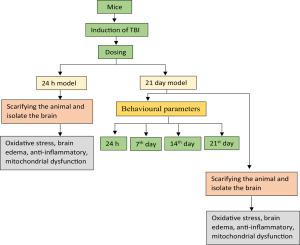Neuroprotective effects of oleanolic acid against secondary cascades of traumatic brain injury in mice
引用次数: 0
Abstract
Introduction
Traumatic Brain Inury (TBI) is a neurodegenerative disorder. Oleanolic acid (OA) is a pentacyclic triterpenoid showed a large number of neuroprotective effects such as anti-alziermer, anti-ischemic etc.
Objectives
In the present investigation an effort has been made to evaluate the neuroprotective effect of OA and molecular mechanism is involved in TBI.
Methods
Weight drop model has been utilized to induce moderate TBI and assess the neuroprotective effect of OA at the doses 50 mg/kg and 100 mg/kg intraperitoneally (i.p.) in mice. After 30 min of injury, OA was administered. The neuroprotective effect of OA was observed after 24 h and 21 days of drug administration. Neurological behaviour (neurological score, open field test, beam walk and morris water maze test) were assessed before sacrifice the animal at different time interval. Oxidative stress (MDA, CAT, GSH, SOD and Nitrite), neuro-inflammatory cytokines (NF-ĸB, TNF-α, IL-6 and IL-1β and mitochondrial dysfunction were evaluated.
Results
OA at both the doses significantly improved the neurological behaviours as compared to vehicle treated group. OA also showed significant anti-oxidant and anti-inflammatory effect via regulated the oxidative stress (MDA, CAT, and GSH) and inflammatory cytokines (TNF-α, IL-6, NF-ĸB and IL-1β) on 24 h and 21st day of injury. OA significantly reduced the mitochondrial dysfunction by regulated various complex enzyme activity.
Conclusion
OA can be potentially considered as a neuroprotective compound for therapeutic management of TBI.

齐墩果酸对小鼠脑外伤继发级联的神经保护作用
导言创伤性脑损伤(TBI)是一种神经退行性疾病。Oleanolic acid(OA)是一种五环三萜类化合物,具有抗阿尔茨海默氏症、抗缺血等多种神经保护作用。损伤 30 分钟后,给小鼠注射 OA。用药 24 小时和 21 天后,观察到 OA 的神经保护作用。在不同时间间隔牺牲动物前,对其神经行为(神经评分、开阔地测试、横梁行走和莫里斯水迷宫测试)进行评估。对氧化应激(MDA、CAT、GSH、SOD 和亚硝酸盐)、神经炎症细胞因子(NF-ĸB、TNF-α、IL-6 和 IL-1β 以及线粒体功能障碍进行了评估。通过调节损伤后 24 小时和第 21 天的氧化应激(MDA、CAT 和 GSH)和炎症细胞因子(TNF-α、IL-6、NF-ĸB 和 IL-1β),OA 还显示出明显的抗氧化和抗炎作用。通过调节各种复合酶的活性,OA 可明显降低线粒体功能障碍。
本文章由计算机程序翻译,如有差异,请以英文原文为准。
求助全文
约1分钟内获得全文
求助全文
来源期刊

Brain disorders (Amsterdam, Netherlands)
Neurology, Clinical Neurology
CiteScore
1.90
自引率
0.00%
发文量
0
审稿时长
51 days
 求助内容:
求助内容: 应助结果提醒方式:
应助结果提醒方式:


